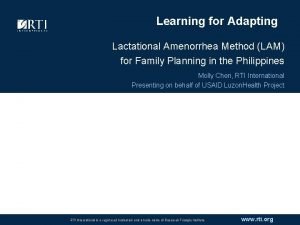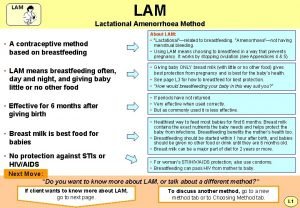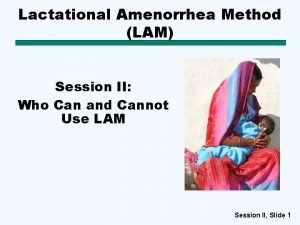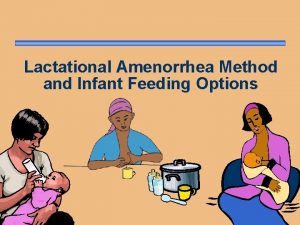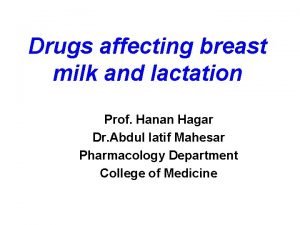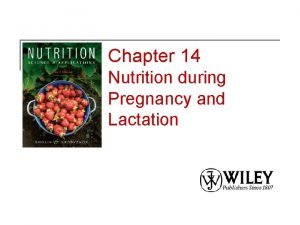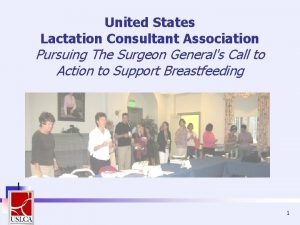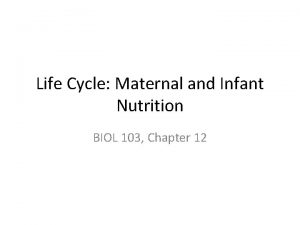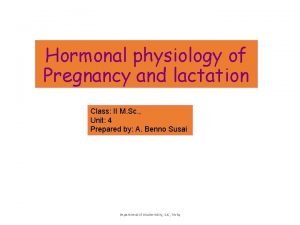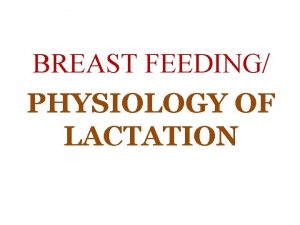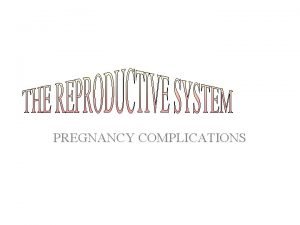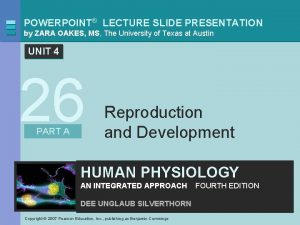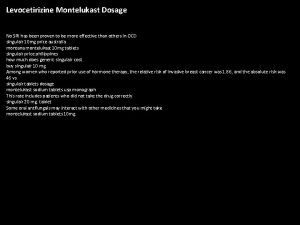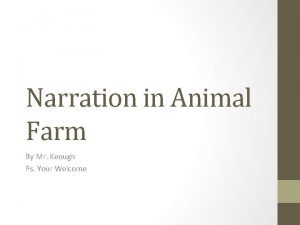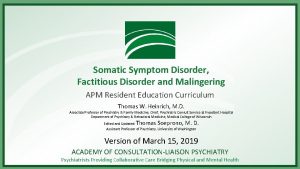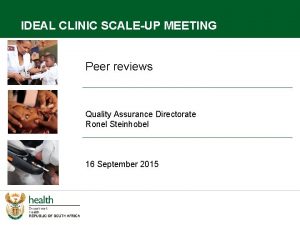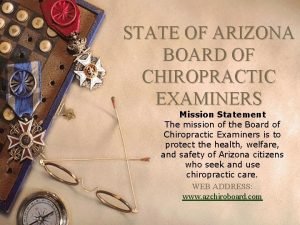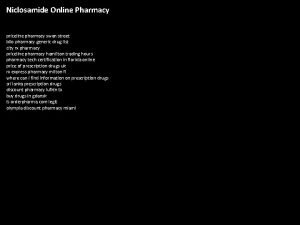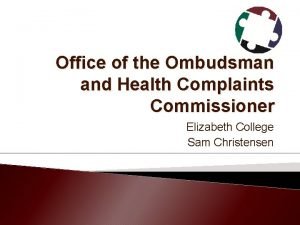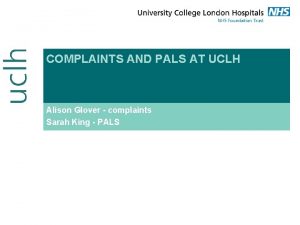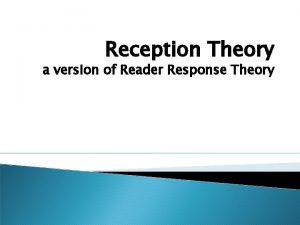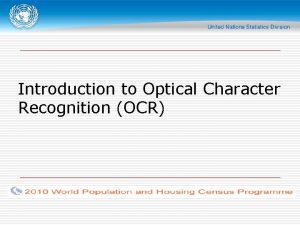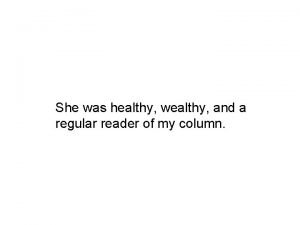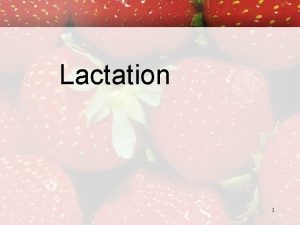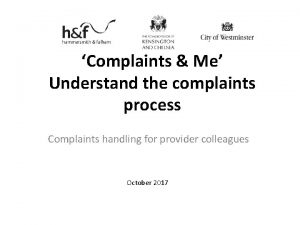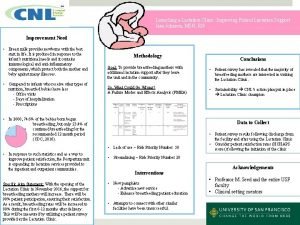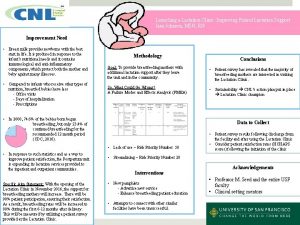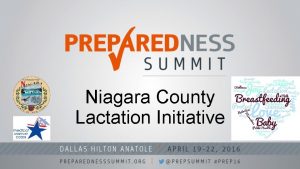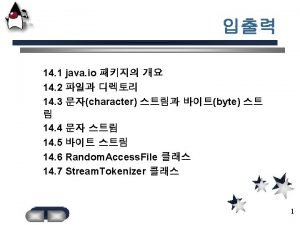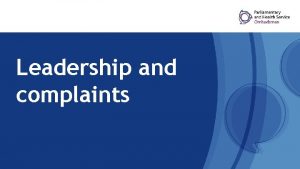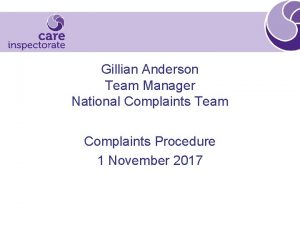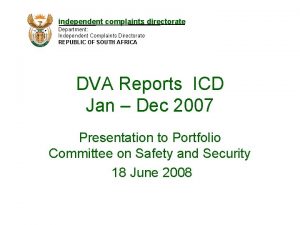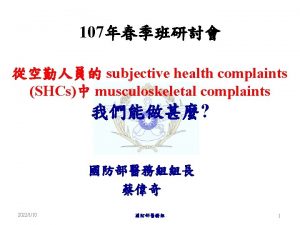LACTATION AND LACTATIONAL COMPLAINTS DR L GIRIJA READER


















































- Slides: 50

LACTATION AND LACTATIONAL COMPLAINTS DR. L. GIRIJA. , READER, DEPARTMENT OF GYNAECOLOGY AND OBSTETRICS, UNIT HEAD MOTHER &CHILD CLINIC SARADA KRISHNA HOMOEOPATHIC MEDICAL COLLEGE, KULASEKHARAM, KANYAKUARY DST, TAMILNADU 1

Physiology of lactation • Mamogenesis (Mammary duct-gland growth & dev. ) • Lactogenesis (Initiation Of milk secretion in alveoli) • Galactopoiesis (Maintenance of Lactation) • Galactokinesis (Removal of Milk from Gland) 2

3

Prolactin “milk secretion” reflex Enhancing factors Hindering factors Early initiation of breastfeeds Delay in initiation of breastfeeds, Pre-lacteal feeds, Bottle feeding, Incorrect positioning, Painful breast Good attachment & effective suckling Frequent feeds including night feeds Emptying of breast Sensory impulse from nipple Prolactin in blood 4

Oxytocin reflex Inhibited by Stimulated by • Thinks lovingly of baby • Worry • Sound of the baby • Stress • Sight of the baby • Pain • CONFIDENCE • Doubt 5

6

Feeding reflexes in the baby Rooting reflex Sucking reflex Child to instinctively suck at anything that touches the roof of their mouth. Swallowing reflex Rooting reflex A newborn infant will turn his head toward anything that strokes his cheek or mouth, searching for the object by moving his head in steadily decreasing arcs until the object is found. IT is present at birth; disappearing at around four months of age as it gradually comes under voluntary control. 7

• Healthy mother secrets about 600 ml (up to 850 ml) milk per day during first 6 months • Nutrition expert committee prescribed additional calories 550 and 400 respectively for 0 -6 months and 6 -12 months • Practices to avoid – Alcohol, drugs, smoking, excess caffeine 8

"No two mothers produce identical milk. The composition of mother’s milk varies from day to day and during different times of the day. The colostrum the baby receives on the first day of his life is different from the colostrum on day two or three. " 9

Benefits of Breastfeeding Benefits of Mothers Breastfeeding helps in • Quick recovery after childbirth, with reduced risk of postpartum bleeding. • Early return to their pre-pregnancy weight. • Enhancing the feelings of attachment between the mother and infant • Preventing pregnancy. • Helps in involution of uterus • Decreases mother’s workload, saves time and energy • Lowers risk of breast and ovarian cancer Breast Feeding reduces the risk of • • Ovarian and pre-menopausal breast cancers. Osteoporosis. Long-term obesity. Anemia by delaying the return of the menstrual cycle. 10

Benefits for Infant • Breastfeeding provides benefits for full-term as well as premature and low birth weight infants. Breastfed children • Are healthier and have fewer symptoms and shorter illnesses when they get sick. • Score higher on cognitive and IQ tests at school age, and also on tests of visual acuity. • Have a lower incidence of sudden infant death syndrome (SIDS). • Are less likely to suffer from infectious illnesses and their symptoms (e. g. , diarrhea, ear infections, respiratory tract infections, meningitis). • Have a lower risk of the two most common inflammatory bowel diseases (Crohn’s disease, ulcerative colitis). • Suffer less often from some forms of cancer (e. g. , Hodgkin’s disease, childhood leukemia). • Have a lower risk of juvenile onset diabetes. • Are significantly protected against asthma and eczema. 11 • May have a lower risk of obesity in childhood and in

12

VARYING COMPOSITION OF BREAST MILK ü Colostrum – secreted during first three days after delivery. It is yellow, thick containing more antibodies and cells and high amount of vitamin A, D, E and K ü Transitional milk – milk secreted next two weeks. Proteins and immunoglobulin decrease and fat and sugar increase ü Mature milk – follows transitional milk. Contains all essential nutrients for baby growth ü Pre term milk – mother who delivers prematurely contains more protein, sodium, iron, immunoglobulin and calories, as they are needed to pre term babies. ü Fore milk – milk secreted at the start of feed. It is watery, rich in protein, sugar, vitamins and minerals. ü Hind milk – comes later towards end of feed. Provides 13 fat

COLOSTRUM • The Colostrum is one of the best things that a mother can give to the baby. • It is the watery - yellowish fluid that comes in first 3 days from the mammary glands. • It is rich in protein. It contains immunoglobulin's (Ig. G, Ig. A), which confers immunity to certain infections (Polio, measles, influenza etc) during first few months of life. So, Colostrum is considered as the first immunization to the infant. • Enzymes like lysozyme, peroxidase and xanthine oxidase that promote cell maturation are found in colostrum. • Colostrum is rich in leucocytes that fight against viruses and 14

BREAST MILK Protiens Fat Carbohydrates Water Colostrum 8. 6% 2. 3% 3. 2% 86% B. Milk 1. 2% 3. 2% 7. 5% 87% Cow’s Milk 3. 4 3. 5 4. 5 88% • 600 ml/day of human milk is enough to meet the nutritional requirement up to first 6 months • Beyond 6 months, the mother’s milk alone 15

FEEDING POSITIONS • Feeding can be done in any position in which mother and baby are comfortable. • The child should be attached properly to the breast so as to insert whole nipple and most of areola in her/his mouth. • The head and body should be in one line and supported and child should be held close to breast. 16

17

Cradle hold cross cradle hold Football hold Side lying 18

Signs of good attachment Signs of effective suckling More of areola visible above the baby’s mouth Mouth wide open Slow, deep sucks, sometimes pausing Lower lip turned outwards Baby’s chin touching breast 19

First feed Frequency of feeding In the case of normal delivery and in absence of any medical complication • Put baby to breast within ½ - 1 hour. In the case of cesarean section. • Duration may be increased to 4 -6 hours. During the first 24 hours • • Feed the baby at the interval of 2 -3 hour • Establish regular pattern of feeding at the interval of 3 -4 hour, not less than 8 feeds / day. By the end of the first week Feed the baby more on demand. 20

Demand feeding • Duration of feed • Night feed • Amount of feed • • Put the baby to the breast as soon as he/she becomes hungry. • There is no restriction of the number of feeds and duration of suckling time. Feed initially for 5 -10 minutes at each breast (to condition let down reflex). • Thereafter, gradually increase the time spent. • Feed the baby completely from one breast so that baby gets both the foremilk and the hind milk (richer in fat and calories). • Put the baby to other breast if required. • Start the next feed from second breast. In the initial period, give night feed to avoid long interval between feeds. (To avoid engorged breast and hardening of the breasts) • Later, usual 3 -4 hourly feeding pattern is established. Average requirement of milk : 100 ml. / kg / 24 hours on the third 21 day and increases

• • Nipple confusion Burping Baby friendly hospital Humanization of cows milk 22

Medicines contraindicated during lactation • Chemotherapeutic agents. • Drugs of abuse e. g. marijuana, heroin, PCP, nicotine, etc. • Radioactive compounds • Anti-anxiety, antidepressants, and antipsychotic medication's effects are not known but are of concern. 23

Conditions those are contraindicated for breastfeeding Conditions that are not contraindicated for breastfeeding In infant • Mother taking antiretroviral medications • Mother with Hepatitis B surface antigen positive • Mother with Hepatitis C infection • Cytomegalovirus (CMV) infection in mothers • • Infant with galactosemia. In Mothers • Mother with active tuberculosis • Mother infected with the HIV • Mother is on medications In all full term infants, the benefits of breastfeeding appear to outweigh the risk of 24. transmission from

EXPRESSED BREAST MILK (EBM) Indications – Sick mother, local breast problems – Preterm / sick baby – Working mother Methods • Manual expression • Breast pump Storage – Clean wide-mouthed container with tight lid – At room temperature: 6 hrs – Refrigerator: 24 hours; Freezer (20°C): for 3 months • It is not advisable to boil the EBM. Feed with cup or spoon or paladai, never feed with bottle. 25

26

Common complications of breast in puerperium �Breast engorgement �Cracked/flat nipples �Mastitis and Breast abscess �Failing lactation 27

BREAST ENGORGEMENT Causes • Delay in starting breast feeding • Infrequent feedings • Restriction of length of feed; small feedings may cause incomplete emptying of the breast. • If the breast-feeding is suddenly stopped by mother or if the baby stops taking the feeds. • If the baby’s breast milk intake drops, due to weaning to solid foods or illness. Infrequent feeding Breast engorgement Infective mastitis Difficulty to latch on properly for the baby Noninfective mastitis Incomplete Incomple emptying tebreast of emptying of breast Milk stasis 28

BREAST ENGORGEMENT � Onset �On the 3 rd or 4 th day due to increased milk production � Symptoms: �Pain, tenderness or heaviness in the breasts �Mild fever �Painful feeding � Prevention: �Manual expression or with breast pump � Treatment : �Support & promote the use of brassiere after delivery �Ice bag application �Baby to be fed regularly �EBM if more left after feed 29

BREAST ENGORGEMENT Homoeopathic management • Conium maculatum • Belladona • Calendula officinalis • Phellandrium aquaticum • Bryonia alba • Lac caninum • Phytolacca decandra 30

CRACKED AND SORE NIPPLES Maternal Causes • Poor breast feeding technique: Infantile Candida infection (Oral Thrush) • Unhygienic habits causing the crust formation over the nipples. • Retracted nipples. 31

CRACKED/FLAT NIPPLES Cracked nipples may become a painful condition due to a fissure on the surface. Condition is asymptomatic but becomes painful due tosucking Prevention: Cleaning of the crust on the nipple after every feed Proper latching of the baby during every feed Treatment: Mothers foremilk applied on the cracks helps in the healing Nipple shield – to prevent direct contact with the breast 32

• With the above measures cracks heal in 1 -2 days but if not • Rest for 24 hrs from feeding • Bandaging of the wound with local antiseptic ointment • If the crack or fissure remains non healing, a surgical opinion should be taken to rule out malignancy Flat nipple: 33

Mastitis and Breast abscess Acute mastitis is the inflammation of the breast following infection It is of two types � Cellulitis (infection through cracked nipple) � Primary adenitis (infection through lactiferous duct) • Encourage mother to continue breastfeeding. • Teach correct positioning and attachment. • Give appropriate homoeopathic treatment. • Reassess in 2 days. • If no improvement or worse, refer to hospital. • Express milk from the affected breast and discard until no fever • Improvement - Continue same measures • No improvement or secondary infection - Refer to Obstetrician for management 34

Mastitis Homoepathic Management • • Castor equi Graphites Phytolacca decandra Ratanhia peruviana Sarsaparilla officinalis Calendula officinalis Phellandrium aquaticum • • • Arnica Borax Calcarea carbonica Chamomilla Croton tiglium Hamamelis Helonias Pulsatilla Sepia Silicea Sulphur 35

FAILURE OF LACTATION AND DEFICIENT LACTATION Signs that baby is not receiving adequate amount of milk • The baby spends less time at the breast (may be 510 minutes rather than 15 -20 minutes). • Baby is not satisfied with the feed and does not sleep well and cries often. • Weight loss is more than 10% in the first week of life. • Baby does not gain at least 160 gm in the following weeks or a minimum 300 gm in the first month. 36

Causes of insufficient milk production • The mother has a health condition that may temporarily delay the increase in milk production usually seen between three to five days postpartum. In such conditions, the production of milk is insufficient until 7 to 14 days after giving birth • Severe stress • Delivery by cesarean section • Postpartum hemorrhage • Retained placental fragments • Prolonged bed rest during pregnancy • Certain medications such as oral contraceptives, antihistamines and sedatives • Smoking, excessive caffeine. 37

“Not Enough Milk”: Management • • • Put baby to breast frequently Baby to be correctly attached to breast Build mother’s confidence Back massage and relaxation can help Use Homoeopathic galactogoges Adequate weight gain and urine frequency 5 -6 times a day are reliable signs of enough milk intake 38

• • “Homoeopathic Galactogoges” Homoeopathic management Lac defloratum Agnus castus Asafoetida Urtica urens Ricinus communis Lac caninum Medusa Galega • • Zincum metallicum Calcarea carbonicum Phytolacca Pulsatilla 39

Breast milk suppression: • It becomes essential in conditions of fetal demise • Patient is advised tight breast support • There should be minimal stimulation of the nipples with no expression of milk as far as possible 40

Belladonna Too copious flow of milk. • Inflammation of breasts, in streaks or rays, diverging From centre to Circumference. 41

Calcarea carbonica • Profuse secretion of watery milk, which the child refuses to take. • Excessive lactation, with hectic fever, and sweat, and debility. • Breasts distended, milk scanty. • Milk disagrees with the infant. • Milk has a disagreeable, nauseating taste; child will not nurse, and cries much. 42

Lac caninum • Galactorrhoea. • Or, loses milk while nursing. • Serviceable in almost all cases were it is required to dry up milk. (ALUMEN, BELL. ). • Decrease in size of breasts, and diminished secretion of milk. 43

Phosphoricum acidum INTOLERANCE OF MILK • Vomiting of milk in a suckling. • Waxy face: blue rings round eyes. • Child does not cry. 44

Aethusa cynapium • Intolerance of milk (Mag. carb. ). • Vomits everything taken, especially milk ejected in curds. • After vomiting, the child is so exhausted, it falls asleep at once. • After vomiting, relaxed and drowsy. 45

SORE NIPPLES • Remedies indicated: - Graph, Lyco, Petrol, Puls, Sep, Sil or Sulph will cure them. • Arnica – when in the first day of nursing, nipple feels sore. • Chamomilla – nipples inflamed, tender, pain unendurable • Croton tig. – Pain from nipple to scapula during nursing. 46

AGALACTICA • Acon, Asaf, Bell, Bry, Calc c, Caust, Cham, China, Coff, Dulc, Merc s, Puls, Rhus t, Sec c, Sulph, Zinc, Calc p, Nat m. • Alfalfa – Disorders characterized by malnutrition. • Lactuca virosa –Sense of lightness and tightness affecting whole body especially chest. • Lecithin –renders milk more nourishing and increases quantity. Anaemia and convalescence, neurasthenia and insomnia marked. • Sticta –feeling of dullness and malaise, as when a cold is coming on. Rheumatic and catarrhal symptoms may be associated. • Urtica urens –agalactia and lithiasis. Gout and uric acid diathesis. • Ricinus 47

GALACTORRHOEA • Acon, Bell, Bry, Borax, Calc c, China, Con, Iod, Lyco, Phos, Puls, Rhus t, Stram • Solanum olera – swelling of mammary glands with profuse secretion of milk Conditions associated with galactorrhoea • Cases of deteriation of health from nursing – Calc, Calc p, China, Lyco, Phos a, Sulph and Silicea • Cramps in stomach – Carb an, Carb veg, China, Phos • Emptiness in pit of stomach from nursing –Carb an, Sep, Ign, Oleander 48

Infant, nursing, aversion, mother’s milk – • Antim c, Cina, Lach, • Merc, Sil, Stan, • Stram 49

THANK YOU 50
 Lactational amenorrhea
Lactational amenorrhea Lam contraception method
Lam contraception method Lactational amenorrhea method
Lactational amenorrhea method What is lactational amenorrhea method
What is lactational amenorrhea method Plasma protein binding
Plasma protein binding Lactation physiology
Lactation physiology United states lactation consultant association
United states lactation consultant association Lactation
Lactation Parturition
Parturition Lactation
Lactation Lactation mastitis treatment
Lactation mastitis treatment Lactation without pregnancy pictures
Lactation without pregnancy pictures Singulair buy online
Singulair buy online Lactation curve
Lactation curve Difference between tetanus and tetany
Difference between tetanus and tetany I consider your behavior rude irresponsible and offensive
I consider your behavior rude irresponsible and offensive When dealing with a complaint it is vital to remember that
When dealing with a complaint it is vital to remember that Animal farm narration
Animal farm narration Hoarding disorder بالعربي
Hoarding disorder بالعربي Nac burial fund forms
Nac burial fund forms Two complaints of tejanos in 1830.
Two complaints of tejanos in 1830. Epso results
Epso results Fashion world complaints
Fashion world complaints Odp of chief complaints
Odp of chief complaints New apostolic church burial fund
New apostolic church burial fund Presenting complaints of hypertension
Presenting complaints of hypertension Legal profession complaints committee v in de braekt
Legal profession complaints committee v in de braekt Ideal clinic complaints
Ideal clinic complaints Radar screening tool
Radar screening tool Arizona board of realtors complaints
Arizona board of realtors complaints Priceline pharmacy prescription price list
Priceline pharmacy prescription price list Farm service agency complaints
Farm service agency complaints Mount litera zee school gondia
Mount litera zee school gondia Ideal clinic coimbatore
Ideal clinic coimbatore Gotelecare franchise reviews
Gotelecare franchise reviews Tspc sanction list
Tspc sanction list Sage customer complaints
Sage customer complaints Health complaints commissioner tasmania
Health complaints commissioner tasmania Uclh complaints
Uclh complaints Fingal county council complaints
Fingal county council complaints Different marketing strategies
Different marketing strategies Ameren complaints
Ameren complaints Reader response theory
Reader response theory Touch screen input or output
Touch screen input or output Accelerated reader answers
Accelerated reader answers Accelerated reader answers
Accelerated reader answers Ocr full form
Ocr full form Define passive reading
Define passive reading What aspect of robert frost's poetry breaks from tradition?
What aspect of robert frost's poetry breaks from tradition? She was healthy wealthy and a regular reader of my column
She was healthy wealthy and a regular reader of my column How to challenge a reader in a conclusion
How to challenge a reader in a conclusion
